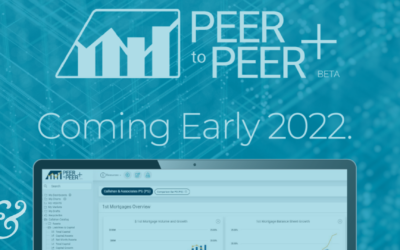More consumers than ever turned to credit unions in 2021. Total industry assets surpassed $2 trillion last year, as over 5.4 million Americans became new credit union members bringing total membership to 131.1 million. Additionally, the industry is seeing accelerated growth in key metrics, including total members, account penetration, and total member relationship.
Two weeks ago, Callahan & Associates shared industry data from the fourth quarter of 2021 in its quarterly Trendwatch webinar. Hundreds of credit unions from around the country joined us for new insights into what the next year for the industry may hold.
“Credit unions are a people-driven business,” Callahan’s President and CEO, Jon Jeffreys, said during the event. “It’s about the members. That’s what we’re here for. That’s how we measure success.”
Credit unions continue to differentiate themselves with an emphasis on being purpose-driven. This value-based banking approach is best exemplified by Clearwater Federal Credit Union ($854M, Missoula, MT) and its president and CEO, Jack Lawson.
“This is how credit unions differentiate themselves,” said Lawson during Trendwatch. “This is how we get people to stand up and take notice. It’s about members. It’s about impact. It’s about helping communities.”
American Consumers Turn To Credit Unions To Reach Their Financial Goals
Membership grew 4.3%, annually, to 131.1 million total members as of December 31, 2021. Both average member relationship and share draft penetration hit record highs at $22,534 per member and 61.2% respectively.
The effects of the government’s stimulus package are finally beginning to smooth out. As a result, an equilibrium is seemingly being found.
In Another Record Year For Credit Union Lending, Consumer Lending Leads Origination Growth
It was a great year for credit union lending. Originations reached a record high, growing 17.2% annually to $795 billion as of December 31. Consumer lending led originations, growing 21.8% annually to a total of $386.5 billion.
Driven by rising home prices, first Mortgage dollar originations grew 7.5% annually to 313.7 billion during the year.
“On the balance sheet, loan growth accelerated during the year as originations outpace early paydowns,” said Callahan industry analyst, Will Hunt. “Excess liquidity is converting into balance sheet loans at a faster rate than we’ve been seeing and borrowing demand is high among members. Credit unions are there to meet that need.”
Historically High Earnings Can Fund Capitalization and Member-Experience Initiatives
As a result of new regulatory requirements from the NCUA, capitalization remained a topic of much discussion for credit union leaders. Still, the industry at large is well-capitalized, but earnings are historically high – industry ROA reached 1.06% though 2021. Total industry net worth continued to grow as a result; up 11.2% to 214.1 billion at the end of 2021. The aggregate credit union net worth ratio remained healthy at 10.3% of assets.
However, these upcoming changes pose a potential confounding factor. Many credit unions might opt to hold onto excess capital, at least during the transitionary period between the old and new reporting standards.
“It will be up to credit union leaders to balance their capital usage effectively across their obligations to both their regulators and their member-owners,” said Hunt. “The ongoing question is how are credit unions going to utilize these earnings to further support members while also balancing regulatory capitalization requirements.”
For more industry data, read Callahan’s 5 Takeaways From Trendwatch or watch the webinar recording on CreditUnions.com.
Callahan credit union clients can access industry data via Peer-to-Peer, CUAnalyzer, and Peer+ on their client portal. Non-clients can request a custom data scorecard here.
More Blogs
Top 5 Articles Of 2021 On CreditUnions.com
It has been a lively year for the credit union industry. A year that started in the throes of COVID-19 has now given way to nationwide economic reopening tempered by labor shortages, inflation, and now, concerns about yet a new variant. Through it all,...
3 Themes For Credit Union CEOs Leading Into 2022
Credit unions have reported a string of significant milestones across 2021. Over the past few months, we've been able to speak with hundreds of credit leaders and wanted to share some of the key themes we’ve been hearing. Digital Transformation Digital transformation...
Alternative Data Sets And How They Can Help Your Credit Union
For credit unions, there’s no such thing as “too much data”. If there’s data that exists for credit unions to get a better gauge on their role in the local community or in the industry at large, it’s in the cooperative’s best interest to uncover it. While typical...
A Successful Launch Starts With A Successful Team
People often ask me why I’m such a passionate credit union advocate. OK, to be honest, the question is usually more along the lines of “why are you obsessed with credit unions”, and the “people” in question are my friends, family, neighbors, kids’ friends’ parents,...
Webinar Recap: How Callahan Quantifies Credit Union Impact
We recently hosted “Measure Your Mission: How To Quantify Credit Union Impact” as part of the quarterly Tableau User Group (TUG) engagement webinar. In it, we outlined the goals of Callahan’s impact initiative, how impact metrics are quantified, and what credit unions...
3 Ways To Use 2Q21 Data
The NCUA has officially released second quarter credit union data. Callahan provides your credit union a multitude of ways to analyze this updated data to benefit your cooperative. Here are three: 1. Build custom tables in Peer-to-Peer In Peer-to-Peer, credit unions...
Recapping The Impact Network Meet-Up
On August 17, dozens of credit unions joined Callahan & Associates for the first ever Impact Network Meet-Up. This event, which was open to Impact Network participants only, was created to help participating credit unions form connections, start impact-related...
2Q21 Credit Union Trends and Takeaways
More than 1,200 industry peers joined us on Aug. 11 for 2Q 2021 Trendwatch. Callahan highlighted trends in lending, membership, and more as behavior amongst credit union members changed in accordance with the steady economic reopening. Most notably, credit union...
We’re Re-Building Peer-To-Peer From The Ground Up, Here’s What You Can Expect
Intuitive design. Faster analysis. Enhanced reporting. All packaged into a sleek, modern interface. Those are just a few of the changes you can expect with the launch of Callahan’s Peer+ software, coming January 2022. We’re excited to share that the classic...
This Month In Impact
This year, Callahan began our impact initiative, in which we seek to build a network of credit unions with the goal of empowering member-owned financial cooperatives to better articulate their value through a mission-focused lens with the help of new metrics and best...











